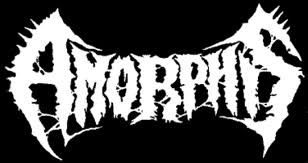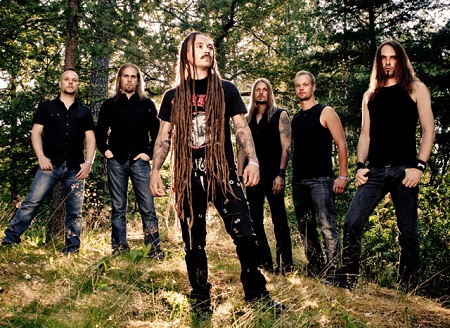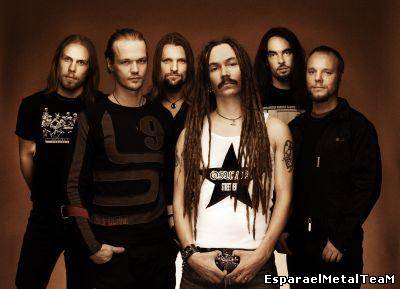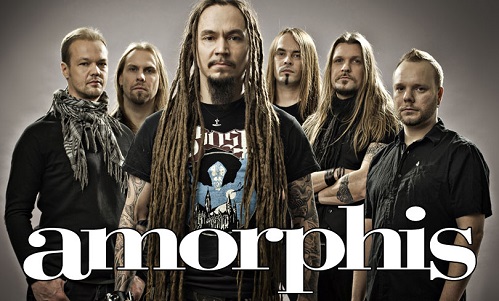| ojotigre | Fecha: Lunes, 2013-04-29, 9:45 PM | Mensaje # 1 |
 EsparaelMetalTeaM
Grupo: Usuarios
Mensajes: 4063
Estatus: Offline
| 
Amorphis
There is power in a name, as ancient wisdom claims. And sometimes a
prophecy. It was a moment of rare foresight when guitarist Esa
Holopainen came up with a name for his new band: Amorphis. Derived from
“amorphous” (without determinate form, shapeless), the choice would
subsequently prove more apt than anyone could have imagined at the time.
It was the fall of 1990, and the band’s two founding members, Esa and
drummer Jan Rechberger, had recently joined forces with
guitarist/vocalist Tomi Koivusaari and bassist Olli-Pekka “Oppu” Laine
to leave their mark on the emerging Finnish death metal scene, only to
transcend it by far and set their sights on new horizons before that
scene even reached the surface of public awareness. From the outset,
Amorphis were determined to follow no vision but their own. Asked a few
months after the band’s conception whether Amorphis would ever change
style if some new trend came along, Esa answered: “We’ll change our
style only if we manage to create something ourselves.” A programmatic
statement for a band that would go on to reinvent itself with every new
album, continuously challenge listeners to forget all their
preconceptions about music, and, through all ups and downs, never bow to
compromise.
In January 1991, Amorphis spent two days in Timo Tolkki’s (Stratovarius)
TTT Studio to record their first, and only, demo. While not satisfying
the critical tastes of the band members themselves, the three-track
Disment of Soul caught the attention of Relapse Records, and the
American label was quick to sign the young band. In May 1991, Amorphis
was already back at TTT to record six songs. Only two of these were
picked for the first 7″ single, but the full session was two years later
released on the EP Privilege of Evil. Frequent club gigs won the group a
devoted fan base even before they entered Stockholm’s famed Sunlight
Studio in May 1992 to record their first full-length album. The Karelian
Isthmus was released in 1993 and, like the four following albums,
distributed in Europe through Nuclear Blast Records. Albeit rightfully
overshadowed by Amorphis’ later work, the assertive debut showcased many
of the elements that would soon become the band’s trademarks. Majestic,
doom-laden riffs combined with concise, folk-influenced guitar leads
and atmospheric keyboard passages set this album apart from many of its
contemporaries and offered a glimpse of future greatness. In recent
years, songs from this album have made a comeback in Amorphis’ live set,
seamlessly blending with the band’s later work and proving they have
indeed stood the test of time.
Although The Karelian Isthmus took its name from a historic Finnish
battleground, its lyrics contemplated universal themes of warfare and
religion, drawing on Celtic mythology rather than the traditions of
Amorphis’ own native land. With its sophomore release, however, the
group reclaimed its Finnish heritage in triumph, creating a monumental
album that single-handedly put the small Nordic country on the map of
progressive metal and is nowadays considered an all-time classic: Tales
from the Thousand Lakes, a concept album based on the Finnish national
epic, the Kalevala. While still strongly rooted in the death metal
tradition, this 1994 release already branched out beyond the usual
confinements of the genre. The boldest step toward a new direction was
the addition of clean vocals, provided by Kyyria’s Ville Tuomi. Ville’s
melodic voice, elegantly contrasting with Tomi’s growls, brought a new
dimension to the band’s sound, as did the greater prominence of
synthesizer and piano. Whereas the synth tracks on the first album had
been laid down by drummer Jan, Amorphis had recently found a full-time
keyboard player in Kasper Mårtenson. Kasper’s best-known contribution to
the band’s repertoire was the song “Black Winter Day”, which was later
released on an EP (flanked by outtakes from the Tales sessions) and
remains a favorite among old and new fans alike.
The success of Tales was immediate and overwhelming. Strenuous tours and
tough schedules, however, took their toll, and Kasper soon decided to
leave the band. A successor was found in Kim Rantala. Jan was replaced
by Pekka Kasari (ex-Stone), and just before recording their third album,
Amorphis recruited a sixth member, singer Pasi Koskinen. With this new
line-up, the band boldly launched into its most adventurous endeavor
yet. Elegy (1996) became a quantum leap for Amorphis, the watershed
between their death/doom beginnings and the unique brand of progressive
rock that has been the cornerstone of their albums ever since. Without
doubt, Elegy was still a metal album, and a highly acclaimed one at
that, yet there was a lot more to it. Its songs were not even based on
guitar riffs anymore but on pure melody, often with a distinct Eastern
touch. The mesmerizing interplay between Kim’s lush synthesizer
arabesques and Esa’s immaculate guitar lines conjured up the spirit of
1970s progressive rock at its finest. Lyrics were again adapted from
Finnish mythology, in this case, the Kanteletar, a collection of ancient
folk poetry. Pasi and Tomi shared the vocals on a roughly equal basis,
with Pasi’s role restricted to the clean parts. To demonstrate the
band’s increasing versatility, an acoustic version of Elegy‘s perhaps
most significant song, “My Kantele”, was added as a reprise at the end
of the album. This acoustic rendition also served as the title track of
the next EP, released in 1997, which contained two new originals as well
as two excellent cover versions of songs by Hawkwind and Finland’s own
heroes of oriental-flavored psychedelia, the legendary Kingston Wall.
After about one and a half years of ceaseless touring following the
release of Elegy, the band members opted for a time-out to recharge
their batteries and think about new material. From the outset it was
clear that the next album would have to do without the massive
production of Elegy and strive for an earthier, less meandering feel.
This decision was in part due to the fact that the band was again
without a keyboardist after losing sight of ever-busy Kim. Toward the
end of the studio sessions, Santeri Kallio of Kyyria was brought in to
add some tasteful keyboard tracks to the songs, but first and foremost,
1999′s Tuonela was a guitar album. Its mellow, understated beauty
displayed the maturity of a band that had fully come into its own,
making music for the sheer joy of playing a good song without wasting a
thought on categories. Even the album’s one “pure” metal track, “Greed”,
was playfully introduced by an Indian-style melody, performed by Tomi
on sitar. Other foreign spices were provided by saxophonist/flutist
Sakari Kukko of world music legend Piirpauke. The guitar parts were
honed to perfection, often reminiscent of Pink Floyd or U2 in their
extensive yet sophisticated use of delay effects. All vocals including
the few remaining grunts were now performed by Pasi, who had also
written almost all of the lyrics. With hindsight, Tuonela may be
considered the most focused Amorphis album of the Koskinen era, each of
its ten songs a timeless gem in its own right yet forged smoothly
together into a coherent whole greater than the sum of its parts.
The new millennium was greeted with the tenth-anniversary compilation
Story and another line-up change. Following the breakup of Kyyria,
Santeri had already joined Amorphis as a full-time member when bassist
Oppu felt he could no longer commit himself to the band. He was
succeeded by another ex-Kyyria member, Niclas Etelävuori, who came in
just in time for Amorphis’ third U.S. tour. Back home in Finland, the
studio beckoned again. Am Universum, released in 2001, retained the
moody atmosphere of Tuonela but introduced more varied soundscapes and a
much wider dynamic range. Instead of letting the guitars dominate
throughout, more space was given to keyboards and saxophone work, the
latter again masterfully contributed by Sakari Kukko. The folk
influences took a step back on Am Universum in favor of a more
experimental approach, allowing for liberated studio jams. In the
literal sense of the word rather than in purely musical terms, this was
Amorphis’ most psychedelic – that is, soul-baring – offering to date,
not in the least due to Pasi’s increased confidence as a lyricist and
singer. The opening track “Alone”, a quintessential Amorphis song, was
released as a single and topped the Finnish charts for three weeks. In
2002 the band was asked for a contribution to the soundtrack for the
movie Menolippu Mombasaan. The commissioned piece was a cover version of
a 1976 Finnish pop hit, “Kuusamo”, which was given the full Amorphis
treatment and remains the band’s only song in their native tongue to
this day.
Amorphis’ longstanding relationship with Relapse Records ended with Am
Universum. In 2003, Relapse released the retrospective Chapters, which
included a DVD featuring the band’s videos from “Black Winter Day” to
“Alone”. Freed from a contract whose smallprint had not always been in
their best interests, the band members decided to record the next album
on their own terms and shop for a label with the finished product in
hand. Far From The Sun was produced by the band itself, which had been
rejoined by original drummer Jan Rechberger after Pekka Kasari had quit
to concentrate on family duties. Recording most of the tracks at Niclas’
and Santeri’s own CCPC studio obviously added to the relaxed and
intimate feeling of this album. Involving no guest performances apart
from some background vocals, it came closer to Amorphis’ live sound than
any of their previous recordings did. Compared to Am Universum, Far
From The Sun turned out heavier, more straightforward and also once
again more folk-oriented, journeying deep into Turkish and Persian
territory. The album was released by Virgin/EMI in the spring of 2003,
but only in Europe. The US release had to wait until the fall of 2004
and would have been accompanied by a North American tour, had not fate
stepped in. The tour itself was ultimately canceled for reasons beyond
the control of the band, yet the prospect of it gave Pasi the reason he
had been looking for to leave the band after nine years and concentrate
on his various other musical projects.
The search for a new frontman was no easy task. Of more than a hundred
demos submitted by hopeful candidates, not one fit the criteria. In the
end, Amorphis found the right person through word of mouth: Tomi Joutsen
(Sinisthra), a powerful, multi-faceted singer with breathtaking
on-stage charisma. His intense, deeply emotional delivery immediately
won the crowds over at each concert the band gave in 2005, including a
one-month tour of North America. Himself a fan of Amorphis since their
early days, Tomi brought not only new vigor and a fresh perspective to
the band but also the initiative to revive the use of contrasting vocal
styles that had contributed so much to the magic of Elegy and Tales.
Befitting this choice, the band – which by then had signed with its
trusted partner of old, Nuclear Blast – decided to reconnect with its
own past on another, even more surprising level with a thematic return
to the sources of Finland’s literary heritage. Eclipse (2006) recounted
the fate of Kullervo, the most tragic character of the Kalevala. The
vast dramatic scope of the ancient tale provided the canvas for Amorphis
to paint an all-encompassing masterpiece which went straight to the top
of the Finnish charts, as did the accompanying single House of Sleep.
Ensuing club gigs and festival appearances all over Europe at long last
established Amorphis as a first-rate live act, all the while new songs
were already in the making. Released in August 2007, Silent Waters
confirmed that a new era had indeed begun: this album was the first in
the band’s long history to have been recorded with the same personnel as
the previous one. Stability, however, does not mean stagnation for
Amorphis. While continuing along the lines of Eclipse in both musical
and lyrical terms – as opposed to earlier albums, which often differed
radically from one to the next – Silent Waters has its own distinct
atmosphere and tells a quite different story, namely Lemminkäinen’s hunt
for the Swan of Tuonela. Its somber mood was gracefully captured in the
outstanding cover artwork by renowned US artist Travis Smith, who has
been responsible for the band’s album and single covers since 2006
including the latest releases. Both Eclipse and Silent Waters went gold
in Finland, a feat not yet accomplished by any earlier Amorphis album,
and won the band a host of new fans around the globe. The remainder of
2007 was spent on the road in northern and central Europe as well as in
Russia and Japan, whereas 2008 found the band in southeastern Europe, at
a multitude of summer festivals and, during the fall, in the USA and
Canada.
Entering the studio straight after returning from a month of intense
touring proved to be a wise choice, as Skyforger (2009) presents
Amorphis tighter, more versatile and more focused than ever. A feast of
musicianship as well as a triumphant statement from a band that has
managed to create its very own sound, the album combines the sheer
energy of Eclipse and the sensitivity of Silent Waters with the
unbridled creativity of older landmarks like Elegy and Am Universum.
While each song from the chart-topping “Silver Bride” to the epic
“Sampo” and the thunderous “Majestic Beast” is a gem in its own right,
the whole effortlessly surpasses the sum of its parts. The lyrics were
again crafted by Finnish poet Pekka Kainulainen and translator Erkki
Virta, who already collaborated on the previous album. Bringing the
archetypal blacksmith Ilmarinen to life with a depth of character far
beyond the one-dimensional portrait of the hero rendered by the
Kalevala, the poetry of Skyforger cements the role of Amorphis as
modern-day storytellers perpetuating an age-old tradition in their very
own way. The album occupied the top spot of the Finnish charts for two
weeks and was subsequently certified gold.
In time for the 20th anniversary, Amorphis released their first-ever
official DVD in July 2010. In addition to a one-hour documentary
covering the Finnish metal pioneers’ entire career, Forging The Land Of
Thousand Lakes features two full concerts recorded in 2009, which
vividly portray the band’s infectious live energy and sheer musical
prowess. Another special release to celebrate the eventful history of
Amorphis followed in September: Magic And Mayhem – Tales From The Early
Years, a retrospective featuring newly recorded songs from the first
three albums. The title of this album also served as the motto of the
anniversary tour in December, for which Amorphis were joined by all
former members.
In January 2011, the band put the finishing touches on its tenth regular
studio album, due for release at the end of May. At the outset of the
third decade, Amorphis continue their musical journey creative as ever –
not confined to any predetermined shape, yet always instantly
recognizable, always true to their own vision, and always unique.

Current line-up
Tomi Joutsen – Vocals
Esa Holopainen – Guitar
Tomi Koivusaari – Guitar
Santeri Kallio – Keyboards
Niclas Etelävuori – Bass
Jan Rechberger – Drums

ALBUMPACK IN LOSSLESS:
Amorphis [1992] [CD]The Karelian Isthmus [EAC-APE]
Amorphis [1993] [CD]The Karelian Isthmus Privilige Of Evil [2003] [EAC-WV]
Amorphis [1994] [CD]Tales From The Thousand Lakes [EAC-FLAC]
Amorphis [1996] [CD]Elegy [EAC-APE]
Amorphis [1997] [CD EP] My Kantele [EAC-FLAC]
Amorphis [1997] [CD]Tuonela [EAC-WV]
Amorphis [2000] [1994] [CD]Tales From Thousand Lakes [EAC-WV]
Amorphis [2001] [CD]Am Universum [EAC-WV]
Amorphis [2001] [CD]Elegy & My Kantele [EAC-APE]
Amorphis [2003] [CD+DVD] Chapters [EAC-FLAC]
Amorphis [2004] [1996] [Digipack][CD]Elegy [EAC-WV]
Amorphis [2004] [CD]Far From The Sun [EAC-WV]
Amorphis [2004] [US CD] Far From The Sun [EAC-FLAC]
Amorphis [2006] [CD]Eclipse [EAC-WV]
Amorphis [2006] [CDS]The Smoke [EAC-FLAC]
Amorphis [2006] [Digipack][CD]Eclipse [EAC-FLAC]
Amorphis [2007] [CDS]Silent Waters [EAC-FLAC]
Amorphis [2007] [DCD]Silent Waters [Digipack][EAC-FLAC]
Amorphis [2009] [CD]Skyforger [Ltd.Edt.] [EAC-APE]
Amorphis [2009] [CDS]Silver Bride [EAC-FLAC]
Amorphis [2010] [CD]Magic And Mayhem-Tales From The Early Years [Ltd. Edt.] [EAC-APE]
Amorphis [2010] [CDS]Forging The Land Of Thousand Lakes (Deluxe Edition)_2010 [EAC-APE] Genre:Death Subgenre:Melodic Metal Bitrate:Lossless Size:9.59 GB
MAS ABAJO OTRO TORRENT
MY NEW TRADE LIST-ABRIL 2016-DVDs-Blue RayS And more KISS
https://mega.nz/#F!c0wGhKCK!PjmDCqhWUnBqyd6mZHezcg
|
| |
|
|













